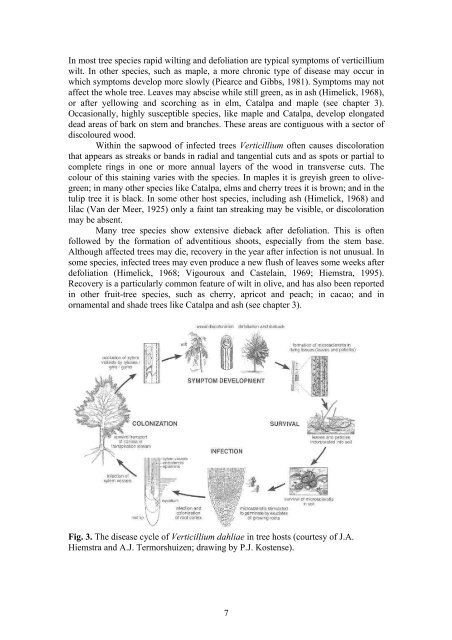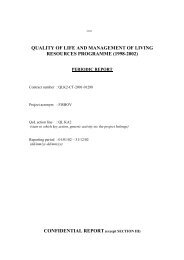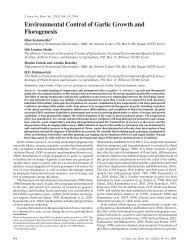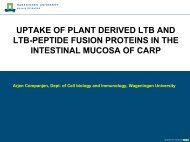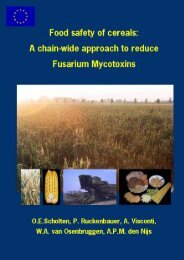2. Some general features of Verticillium wilts in trees
2. Some general features of Verticillium wilts in trees
2. Some general features of Verticillium wilts in trees
You also want an ePaper? Increase the reach of your titles
YUMPU automatically turns print PDFs into web optimized ePapers that Google loves.
In most tree species rapid wilt<strong>in</strong>g and defoliation are typical symptoms <strong>of</strong> verticilliumwilt. In other species, such as maple, a more chronic type <strong>of</strong> disease may occur <strong>in</strong>which symptoms develop more slowly (Piearce and Gibbs, 1981). Symptoms may notaffect the whole tree. Leaves may abscise while still green, as <strong>in</strong> ash (Himelick, 1968),or after yellow<strong>in</strong>g and scorch<strong>in</strong>g as <strong>in</strong> elm, Catalpa and maple (see chapter 3).Occasionally, highly susceptible species, like maple and Catalpa, develop elongateddead areas <strong>of</strong> bark on stem and branches. These areas are contiguous with a sector <strong>of</strong>discoloured wood.With<strong>in</strong> the sapwood <strong>of</strong> <strong>in</strong>fected <strong>trees</strong> <strong>Verticillium</strong> <strong>of</strong>ten causes discolorationthat appears as streaks or bands <strong>in</strong> radial and tangential cuts and as spots or partial tocomplete r<strong>in</strong>gs <strong>in</strong> one or more annual layers <strong>of</strong> the wood <strong>in</strong> transverse cuts. Thecolour <strong>of</strong> this sta<strong>in</strong><strong>in</strong>g varies with the species. In maples it is greyish green to olivegreen;<strong>in</strong> many other species like Catalpa, elms and cherry <strong>trees</strong> it is brown; and <strong>in</strong> thetulip tree it is black. In some other host species, <strong>in</strong>clud<strong>in</strong>g ash (Himelick, 1968) andlilac (Van der Meer, 1925) only a fa<strong>in</strong>t tan streak<strong>in</strong>g may be visible, or discolorationmay be absent.Many tree species show extensive dieback after defoliation. This is <strong>of</strong>tenfollowed by the formation <strong>of</strong> adventitious shoots, especially from the stem base.Although affected <strong>trees</strong> may die, recovery <strong>in</strong> the year after <strong>in</strong>fection is not unusual. Insome species, <strong>in</strong>fected <strong>trees</strong> may even produce a new flush <strong>of</strong> leaves some weeks afterdefoliation (Himelick, 1968; Vigouroux and Castela<strong>in</strong>, 1969; Hiemstra, 1995).Recovery is a particularly common feature <strong>of</strong> wilt <strong>in</strong> olive, and has also been reported<strong>in</strong> other fruit-tree species, such as cherry, apricot and peach; <strong>in</strong> cacao; and <strong>in</strong>ornamental and shade <strong>trees</strong> like Catalpa and ash (see chapter 3).Fig. 3. The disease cycle <strong>of</strong> <strong>Verticillium</strong> dahliae <strong>in</strong> tree hosts (courtesy <strong>of</strong> J.A.Hiemstra and A.J. Termorshuizen; draw<strong>in</strong>g by P.J. Kostense).7


